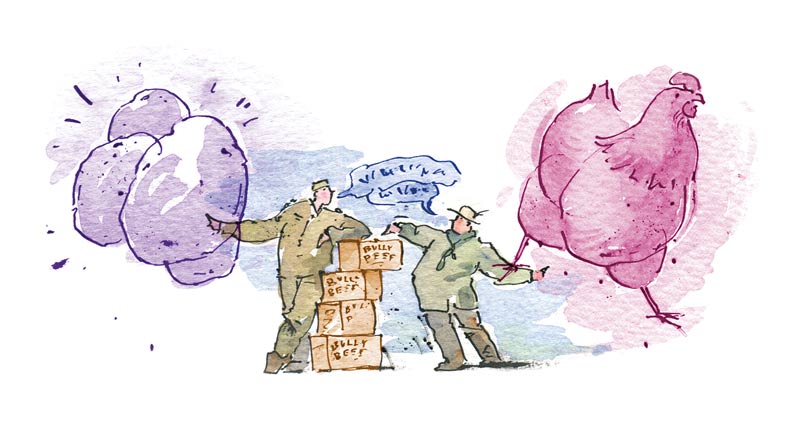
Illustration by Malcolm Jones
Between the late 1940s and the early 1990s, thousands of Canadians served with NATO in Europe. Early on, there were problems with things as simple as clothing and rations, as Canada adjusted to maintaining a large force far from home supply depots. In some cases, the Canadians were served British rations, which seemed to consist largely of canned corned beef known as “bully beef.” Things were especially tough on field exercises when British hard rations became dreary after four or five days.
One group of Canadians, however, found a solution in what became known as the “potato patrol.” They crept into a German potato field one night and dug up enough spuds for their platoon, replacing the vegetables with cans from the pack rations.
When the farmer turned up the following afternoon, there were some anxious moments—until it turned out he just wanted to swap two freshly killed chickens for more canned rations.
The Canadians soon adapted to European life. Many ended up marrying young women from Germany, the Netherlands and Denmark. It’s said these young brides adapted quickly to the Canadian way of life, although one wife made her origins clear at a hockey game one night when she shouted at the referee and labelled him a “chee-ken sheet bastard.”
During the early days in Germany, the language barrier was a problem. Almost none of the Canadians spoke German and few of the locals spoke English. The troops, however, figured they could muddle through most casual conversation with a smile, frequent nods and an occasional “Ja, ja.” This could cause problems, though. After a night out at the local watering hole with some friendly townsfolk, one soldier discovered that he had signed up with the volunteer fire brigade. It worked out for the best, however, and he ended up driving the fire engine.
In 1939, the newly raised 1st Canadian Division arrived in Britain. Its members were the vanguard of an estimated 500,000 Canadians—army, navy, air force—who served in the country for varying lengths of time until the end of the war.
Many of the first arrivals were initially quartered at Aldershot in Hampshire, England. It had been Britain’s largest peacetime military station. By British standards, the accommodations, some dating to Victorian times, were fine. The Canadians, however, were less impressed, particularly since none of the barracks had central heating and the winter of 1939-1940 was the coldest on record since 1894.
The buildings relied on coal- and wood-burning stoves for heat and, even though the Canadians were issued a larger allotment of coal than their British counterparts, they still complained of the cold.
Locals soon noticed that park benches and seats at bus stops were disappearing. The wood, chopped up in nocturnal raids, ended up in the Canadian stoves.
The arrival of French-Canadian regiments in England during the Second World War was a concern for some Brits, worried in particular about unilingual francophones. But one woman, at least, welcomed them. She wrote in a letter: “We now have got Canadians, quite the most charming creatures I have met in this war and as for the French ones among them, words fail me to describe their delightfulness.”
They crept into a potato field one night and dug up enough spuds for their platoon, replacing the vegetables with cans from the pack rations.
After the First World War, Canada had plans for a giant war museum. The army in Europe amassed a collection of captured artillery pieces, vehicles, machine guns, uniforms, flags and other souvenirs that were shipped home for display in the nascent facility. The plan fell victim to troubled national finances, however, so many of the trophies were instead distributed across the country as war memorials in cities, towns and villages. Ottawa’s Hintonburg neighbourhood was allotted a nine-tonne cannon, which was plopped in a little square at the centre of the community.
For years, the Hintonburg Howitzer, as it was known, rusted away in peace. But its welcome eventually wore out. The city wanted to put stoplights in place of the square. An alderman complained the gun was a menace and “merely an attraction for boys.”
A 1934 newspaper editorial described the trophy as “ugly masses of rusty iron less useful than almost anything else in the world, less ornamental than a tree, of not much interest to a anyone.” The editorial went on to say it was a shame the metal couldn’t be turned into ploughshares “but just now, there isn’t much demand for plow-shares (sic) either.”
The howitzer was moved out of sight and ignored until the outbreak of a new war meant a renewed demand for scrap metal. Hundreds of the old trophies across the country were melted down and much of the metal went back to Europe in the form of bombs, shells and bullets.
Advertisement





















